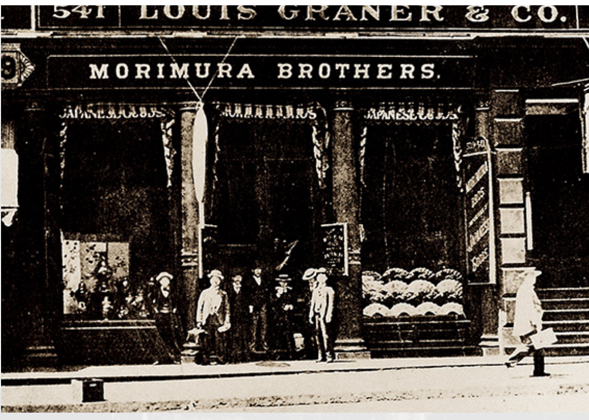
「オールドノリタケ誕生秘話」森村一族が果たした役割
オールドノリタケの誕生には、森村一族が深く関わっています。江戸幕府の250年にわたる統治は、1853年のペリー提督の黒船来航を機に開国へと向かい始めます。これを受けて、1858年(安政5年)7月29日、江戸湾小柴沖に停泊中のアメリカ船ポウハタン号上で、幕府代表の井上信濃守清直とアメリカ総領事タウンゼント・ハリスの間で日米修好通商条約が調印されました。
条約批准書の交換のため、幕府は新見豊前守正吉を特使としてワシントンに派遣することを決定しました。このとき、横浜貿易に精通し、大名屋敷との取引も多かった森村市左衛門(1839-1919)という商人が重要な役割を果たしました。彼はアメリカ大統領への贈答品の調達や、新見の旅に必要な両替を担当したのです。
森村は30人の人夫と10人の侍の協力を得て、3万両(金貨と銀貨30箱分に相当)を横浜まで運び、当時使用されていたメキシコの銀貨と交換しました。

森村市左衛門(1839-1919)
当時、森村市左衛門は、交換で受け取ったメキシコの煤けた銀貨と日本の美しい金銀貨を見比べ、強い不信感を覚えました。また、交換で受け取った金額が減ったことにも大きな疑問を感じました。森村はそのことについて、親交の深かった中津藩奥平家の家老桑名昇に相談しました。
桑名の仲介で、森村は中津出身の武士、福沢諭吉と知り合う機会を得ます。森村がアメリカとの通貨交換で日本の金が流出していることについて福沢に尋ねると、福沢は「大砲の威嚇のもとで押し付けられた通商条約は、確かに不公平ではあるが、現在の日本の国力では、条約の改定は現実的ではない。日本を強くするには、外国貿易を促進し、外貨を獲得しなければならない」と答えます。この助言が森村にとって転機となり、海外事業に乗り出すことになります。

森村豊(1854‐1899年)
1876年(明治9年)、森村市左衛門は海外貿易を目的とした森村グループを創設します。彼は横浜居留地での商売経験や福沢諭吉との交流を通じて、外国商人や商社に頼るのではなく、日本人自身が行う「直輸出」で外貨を稼ぐことの重要性を早くから認識していました。同年、弟の森村豊(1854‐1899年)をアメリカに派遣。豊は1878年(明治11年)、ニューヨークのフロントストリートに店を借り、森村ブラザーズを設立します。当時、ジャポニスムの影響や目新しさから、日本の骨董品、青銅器、扇子、提灯、人形、陶磁器などが大変人気がありましたが、次第に関心は薄れていきました。
1883年(明治16年)、市左衛門と豊は市場調査のためパリ万国博覧会に出席し、ヨーロッパに渡りました。この経験から、森村兄弟は陶磁器の販売に特化することを決めます。ヨーロッパの陶磁器、特にマイセンは100年以上の磁器生産の歴史があり、そのデザインも優れていると高く評価されていました。当初はヨーロッパのデザインを模倣することから始め、やがて西洋のデザインを取り入れた日本の陶磁器の先駆け、後に「オールドノリタケ」と呼ばれる作品がここに誕生しました。
日本の最高峰の技術と感性で作られたオールドノリタケは、伝統工芸と優れたデザインが融合した芸術品として高い人気を博し、現在でも世界中のコレクターに愛され続けています。

オールドノリタケ EB-906 花瓶
通常価格800,000円
プレッツェル型の取っ手が付いた花瓶
バラのデザイン
多色と金のレリーフ
制作時期: 1891年頃、明治中期
モチーフ: 花、バラ
バックスタンプ:メープルリーフ
